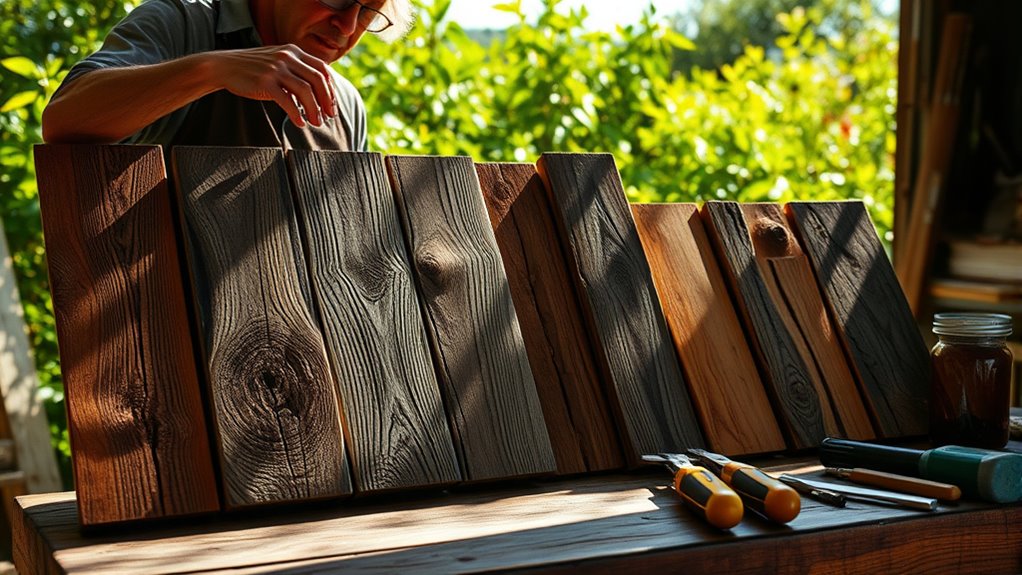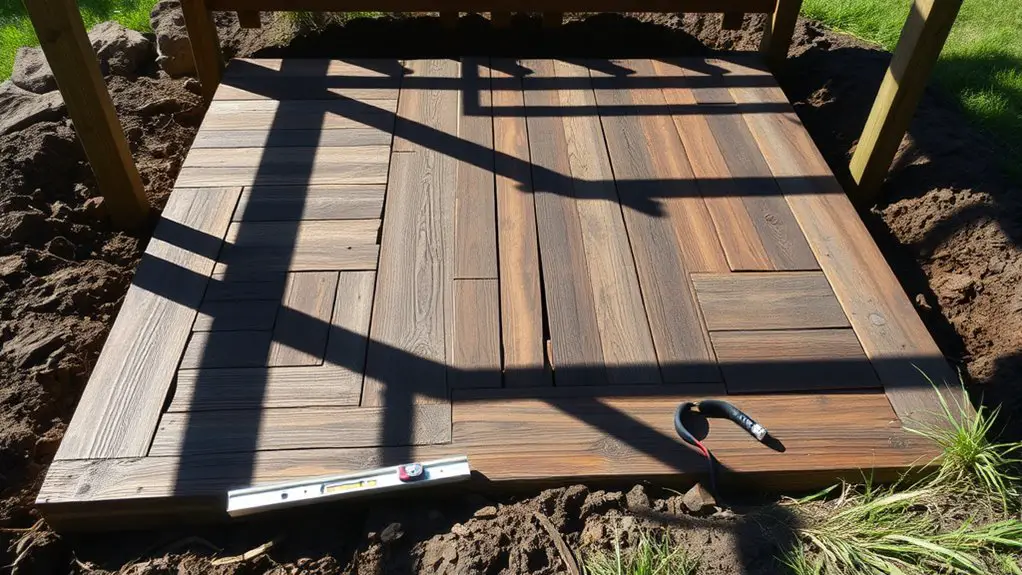To build a gazebo using reclaimed wood, start by choosing durable and aesthetically pleasing materials like oak or cedar, ensuring you inspect for rot or damage. Next, design your gazebo based on your style and space needs. Gather essential tools, then prepare the site by clearing debris and ensuring good drainage. Construct a solid foundation, followed by assembling the structure securely. Finally, apply a sealant for protection and schedule regular maintenance. You’ll uncover further tips for successful construction ahead.
Choosing the Right Reclaimed Wood

When starting your gazebo project, selecting the right reclaimed wood is essential for both aesthetics and durability. You’ll want to take into account various wood characteristics such as grain, color, and texture. Oak and cedar are popular choices due to their strength and resistance to decay, but the unique history of reclaimed wood can provide a distinct charm. Additionally, opting for naturally resistant wood types can enhance the longevity of your gazebo against outdoor elements.
Sustainability factors matter too. By choosing reclaimed wood, you’re reducing demand for new lumber, thereby conserving forests and minimizing your carbon footprint. Look for sources that verify the wood’s origin and confirm it’s free from harmful chemicals or treatments that could compromise its integrity.
Inspect each piece carefully, checking for signs of rot or insect damage, as these can affect the structural integrity of your gazebo. Prioritizing quality reclaimed wood will not only enhance the aesthetic appeal of your project but also contribute to a more sustainable building practice.
Designing Your Gazebo
As you commence on the design phase of your gazebo, it’s essential to reflect on both your aesthetic preferences and functional requirements. This is where gazebo aesthetics come into play. Consider how the structure will complement your outdoor space and provide a welcoming atmosphere. To achieve a harmonious design, you might find inspiration from various sources.
Here are three key aspects to focus on:
- Style: Decide whether you want a modern, rustic, or traditional look to guide your choices.
- Dimensions: Determine the size based on how you plan to use the gazebo, ensuring it fits comfortably within your yard.
- Materials: Choose reclaimed wood that not only fits your design vision but also enhances durability and sustainability. Additionally, selecting the right material options can significantly affect the overall quality and longevity of your gazebo.
Gathering Tools and Materials

Before you start building your gazebo, you’ll need to gather the essential tools and materials. Common tools include a circular saw, drill, and measuring tape, while reclaimed wood can vary from barn wood to pallets. Selecting the right materials will guarantee both durability and aesthetic appeal in your finished structure.
Essential Tools Needed
To successfully build a gazebo using reclaimed wood, you’ll need a specific set of tools and materials to guarantee your project runs smoothly. Prioritize safety precautions by wearing gloves and goggles, and verify proper tool maintenance for longevity. Here’s a concise list of essential tools:
- Circular Saw – Perfect for cutting wood to size and essential for precision.
- Drill/Driver – Critical for assembling your gazebo and driving screws securely.
- Level – Verifies your structure is even and stable, preventing future issues.
Gather these tools before you begin, and familiarize yourself with their operation. This preparation not only enhances efficiency but also contributes to a safe working environment, allowing you the freedom to create your ideal gazebo.
Types of Reclaimed Wood
When selecting reclaimed wood for your gazebo, it’s important to understand the different types available, as each variety offers unique characteristics that can affect both aesthetics and durability. Barn wood is particularly popular for its rustic charm, often featuring rich textures and weathered finishes. Pallet wood can be a cost-effective choice, though it typically requires careful inspection for quality and safety. Reclaimed lumber is versatile, with a range of species available that can complement any design. Salvaged timber, often sourced from old buildings, provides historical significance and resilience. Antique wood brings a sense of history, while vintage planks can add character and uniqueness. Choosing the right type guarantees your gazebo is both beautiful and long-lasting.
Preparing the Site
Before you start building your gazebo, it’s essential to select an appropriate location that provides both stability and accessibility. Make certain the ground is clear of debris, vegetation, and any obstructions that could interfere with the structure’s foundation. Proper site preparation will set the stage for a successful and durable gazebo.
Selecting the Location
How do you guarantee your gazebo not only complements your landscape but also stands the test of time? Selecting the right location is essential. Consider these factors for your ideal spots:
- Sun Exposure: Choose a site with the right balance of sun and shade, securing comfort during peak hours.
- Accessibility: Make sure your gazebo is easily reachable from your home and nearby outdoor areas, enhancing its usability.
- Drainage: Avoid low-lying areas prone to standing water, as this can compromise the gazebo’s stability and the reclaimed wood’s integrity.
Clearing the Ground
To prepare the site for your gazebo, begin by clearing the area of any debris, grass, or vegetation that could interfere with the construction. This ground preparation is vital for a stable base. Perform a thorough site assessment to identify any potential issues like uneven terrain or drainage problems.
| Task | Importance |
|---|---|
| Remove debris | Guarantees a clean base |
| Cut grass | Prevents regrowth |
| Level the ground | Provides stability |
Taking these steps not only enhances the aesthetic of your gazebo but also fosters a sense of freedom in your outdoor space. A well-prepared site paves the way for a successful build, allowing you to enjoy your reclaimed wood gazebo for years to come.
Constructing the Foundation

While you may be enthusiastic to start assembling your gazebo, laying a solid foundation is essential for guaranteeing its stability and longevity. The foundation type you choose will depend on soil stability and the gazebo’s size. Here are three common foundation types:
Laying a solid foundation is crucial for your gazebo’s stability and longevity. Choose wisely based on soil and size.
- Concrete Slab: This provides a level, durable base, ideal for larger structures.
- Post and Beam: Best for uneven terrain, this method uses concrete footings to anchor posts securely.
- Pavers or Gravel: A cost-effective solution, perfect for smaller gazebos; ascertain the ground is well-compacted for stability.
Before you begin, assess the soil’s stability. If it’s loose or sandy, reinforce your foundation to prevent shifting over time. A strong foundation will support your reclaimed wood structure and enhance its lifespan, allowing you to enjoy your gazebo without worry. Additionally, a foundation is crucial for ensuring proper drainage and preventing water damage. Take the time to get this step right, and you’ll reap the benefits for years to come.
Building the Gazebo Structure
Once you’ve established a robust foundation, the next step involves constructing the gazebo structure itself, which requires careful planning and execution. You’ll want to employ effective framing techniques to guarantee structural stability. Start by measuring and cutting your reclaimed wood to the desired dimensions for the posts and beams.
Here’s a quick reference table to help you with your framing decisions:
| Element | Recommended Size |
|---|---|
| Corner Posts | 4×4 inches |
| Beams | 2×6 inches |
| Roof Rafter | 2×4 inches |
| Cross Bracing | 1×4 inches |
As you assemble, guarantee each connection is secure and level. Using metal brackets can enhance stability. Regularly check for square alignment throughout the process. This attention to detail will not only add strength but also enhance the overall aesthetic of your gazebo. Additionally, ensuring that your frame is anchored to the ground will prevent shifting or toppling over time.
Finishing Touches and Maintenance
As you complete the main structure of your gazebo, focusing on the finishing touches and maintenance is vital for both aesthetics and longevity. Proper finishing techniques enhance the appearance while protecting the wood. Here are some maintenance tips to reflect upon:
- Seal the Wood: Apply a high-quality sealant or stain to protect against moisture and UV damage. This should be done annually to maintain the wood’s integrity.
- Inspect Regularly: Check for signs of rot, mold, or insect damage at least twice a year. Early detection is essential to preventing larger issues.
- Clean Debris: Keep the roof and surrounding area clear of leaves and dirt. This prevents water accumulation, which can lead to rot.
- Additionally, regular cleaning and washing of the gazebo’s fabric is essential to maintain its appearance and integrity.
Frequently Asked Questions
Can I Use Pressure-Treated Reclaimed Wood for My Gazebo?
You can use pressure-treated reclaimed wood for your gazebo, benefiting from its durability. However, be aware of reclaimed wood’s drawbacks, like potential chemical residues and structural weaknesses, which could compromise your project’s integrity and safety.
How Do I Ensure the Wood Is Free From Pests?
To guarantee your wood’s pest-free, conduct a thorough pest inspection before treatment. Consider heat or chemical wood treatment methods to eliminate any existing pests, safeguarding your structure from infestations and guaranteeing long-lasting durability.
What Are the Best Finishes for Reclaimed Wood?
When choosing finishes for your reclaimed wood, think of sunlight filtering through leaves. Natural finishes like oils or waxes offer beauty and protection. Explore wood treatment options to enhance durability and maintain that rustic charm you love.
Is a Permit Required for Building a Gazebo?
You’ll often need a permit for building a gazebo, depending on local building and zoning regulations. Check your municipality’s guidelines to guarantee compliance and maintain your freedom to create your outdoor space without future issues.
How Long Will Reclaimed Wood Last Outdoors?
Reclaimed wood’s lifecycle expectations outdoors vary, but with proper treatment, it can last 20-30 years. Its weather resistance depends on species and finish, so ensuring suitable protection is essential for longevity in outdoor environments.

